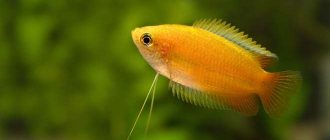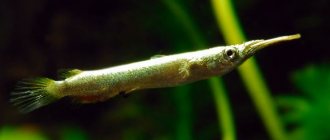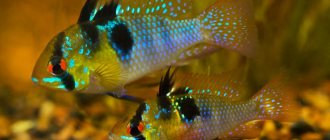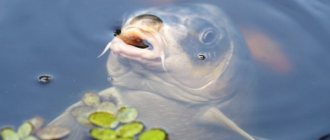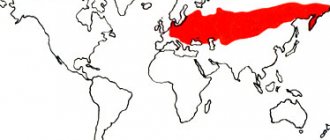Dwarf gourami (Trichopsis pumila) Arnold, 1936.
The tiniest representative of the labyrinthine family. They appeared in the decorative aquarium hobby in 1903 and were brought to the territory of the USSR in 1954.
Synonyms
Russian: Pumila, Gurami pygmy Latin: Ctenops pumilus (JP Arnold, 1936), Trichopsis pumilus var. siamensis (Herms, 1953)
Etymology
Trichopsis: From Ancient Greek (thríx), meaning "hair", and (ópsis), meaning "aspect, appearance", presumably in reference to the elongated thread-like fins most pronounced in males. pumila: From the Latin pumilus, meaning "dwarf."
Order: Creepers (Anabantiformes) Family: Macropods or Guramis (Osphronemidae) Genus: Trichopsis or Dwarf gourami (Trichopsis)
Appearance
The nimble pumila are distinguished by their miniature sizes - the length of the fish is only 3.5-4 cm.
In an aquarium, gourami grow up to 4 cm in length
Description of appearance:
- The head is pointed, the eyes on the sides are large and bright, light blue in color with a red halo.
- Large mouth, jagged gills.
- The body is oblong, laterally compressed.
- The dorsal fin is high, sail-shaped, and not wide.
- A pair of pelvic fins of a modified filamentous shape. They act as tactile organs and look like antennae.
- The anal fin is the widest - it originates from the ventral formations and extends to the caudal peduncle.
- The tail is rounded, with a widening at the end.
The main body tone is olive green with a pearlescent iridescent tint.
A dark or light brown intermittent wide stripe runs from the snout along the central part of the body. Above, parallel to it, there is a group of chaotic large gray-brown spots and bright small inclusions of green and blue. The belly is white, with a pale pink pearlescent tint. The background of the fins is transparent, with a complex pattern - frequent dotted inclusions of azure blue and black. A wide red-scarlet edging runs along the edges.
What does a dwarf gourami look like?
These are the smallest of the entire family of fish. Their length is 3.5, less often 4 cm. Their body shape is oblong. The body is flattened laterally. It is not as high as other gouramis.
The fin on the back is short and resembles a sail. The anal fin begins almost at the ventral fin and extends to the rounded tail. The fins on the abdomen are modified and look like whiskers.
The head ends in a large mouth. There are serrations on the edges of the gill covers. The labyrinthine organ is underdeveloped.
The coloring of these babies is not too bright. On the main olive background with a blue tint, greenish and bluish spots are scattered. The back is a dark olive color, the belly and caudal peduncle are greenish-whitish, and the chest is pinkish.
From head to tail, the body is divided almost in half by a thin strip made up of large black and blue dots. Blue and green spots are sparsely scattered on both sides of it.
The eyes are pinkish, and in certain lighting they are bright blue. The bluish-green fins (except those on the chest and abdomen) are strewn with dark specks and edged with dark red.
Males can be identified by their brighter coloration, somewhat larger size, slender body constitution and elongated dorsal and anal fins. They live from 3 to 5 years.
MARBLE GOURAMY CARE SPAWNING PHOTO VIDEO DESCRIPTION COMPATIBILITY.
Habitat
Gourami pumila is a representative of Southeast Asia. It inhabits the waters from Indonesia, Thailand, Laos to Vietnam. Habitats:
- rivers;
- streams;
- ditches;
- pits.
Typical gourami habitats are ditches, pits and rivers with a small current.
Prefers weak currents and abundant vegetation.
The water in the area's aquatic systems has a low oxygen content and poor visibility. It is precisely these difficult living conditions that justify the presence of two additional organs in the pumila fish - respiratory and tactile.
The labyrinthine apparatus is located in the epibranchial cavity and saturates the body with atmospheric air. Long modified rays of the pectoral fins help gourami navigate through the thick muddy water.
Notes
It can be distinguished from its relatives by its small adult size and the presence of one continuous dark longitudinal lateral stripe on the body, above which there is a series of dark dots forming a second stripe. In the similar but larger Gourami Schalleri (Trichopsis schalleri), the upper stripe is more variable depending on the mood of the fish, sometimes disappearing completely.
The common name comes from the ability of members of the genus to produce audible sounds using a special pectoral mechanism that is unique to the family Osphronemidae. This structure consists of modified pectoral fin tendons and muscles that are stretched and plucked by the basal portion of the anterior fin rays like guitar strings. The pectoral fins beat alternately, each of which is capable of generating short or long sound pulses. These sounds are produced by both sexes, primarily during mating interactions, and they vary in timing between species. Research shows that Trichopsis species are able to resolve conflicts without physically harming each other by assessing factors such as body mass and body length, which are conveyed by both visual and acoustic "croaking" signals. During courtship, the female makes "purring" sounds to initiate spawning, and they are the only fish that do this.
Like others in the suborder Anabantoidei, this species possesses an accessory respiratory organ known as the labyrinth, which allows the fish to breathe atmospheric air. Consisting of paired suprabronchial organs formed by expansion of the epibranchial (upper) portion of the first branchial arch and located in a chamber above the gills, it contains many highly vascularized* folded flaps of skin that function as a large respiratory surface. Its structure varies in complexity between species and tends to be more developed in those living in harsher environments.
*Vascularization is the provision of blood vessels and, therefore, blood to organs, areas and parts of the body.
Character
Although the pumila's body shape resembles a fighting fish, its character is peaceful and calm. In the aquarium it shows caution and, in the absence of danger, behaves actively. Gourami are not schooling fish, but it is recommended to keep them in a group of at least 8 specimens - 1 male for 3 females. The numerical superiority of females will reduce territorial aggression among the dominant representatives of the species - males.
Gourami can do well both in a group and alone
Care and maintenance
For a fish like the dwarf gourami, keeping it in an aquarium requires a properly prepared habitat. Before settling the pumila, the water must be well matured with a stable biocenosis. To do this, the tank with soil and aquaculture is kept for about two weeks before the fish are released.
Pumila gourami are “talkative” fish. During the spawning period, they make rumbling sounds similar to squealing.
Aquarium
For a flock of 8 fish, you will need an aquarium with a capacity of 40 liters or more, on the basis that a couple of individuals should have at least 5 liters of volume. The recommended shape of the structure is rectangular, so that the length prevails over the height. The aquarium is covered with a lid so that the air above the water surface is not cold.
The aquarium for keeping gourami can be quite small, but not less than 40 liters
Since the fish are endemic to the tropics, they love a soft, slightly acidic warm habitat.
Optimal physical and chemical water parameters for dwarf gourami:
- temperature – 25-28 °C;
- hardness – 2-12 dH;
- acidity – 5.0-7.0 pH.
Pumila is hardy and easily tolerates temporary unfavorable conditions. To eliminate organic load, water is changed weekly (30%).
Despite the fact that the dwarf gourami can breathe atmospheric air, the labyrinthine organ of the pumila is poorly developed. Therefore, as equipment for the aquarium, you will need a filter and an aerator. They are installed so that there is no strong current in the water.
In the cold season, tropical fish need an additional source of heat. For these purposes, a water heating element with a thermostat is installed.
Lighting
The lighting in the aquarium should be moderate, as intense light frightens modest fish. The bright stream of lamp equipment is diffused by abundant vegetation and shaded by driftwood and ceramic decorations.
Aquarium lighting should provide enough light, but too much light is also harmful.
Plants and soil
Choose any soil that will promote good rooting and growth of aquacultures. Dark colors are preferred to minimize light reflection. Often siphoning the bottom is not recommended, since the dwarf gourami loves silted substrate.
For the comfort of small pumilas, live crops are planted in the tank:
- hygrophila;
- pinnate;
- Vallisneria;
- Echinodorus.
Vallisneria – decorative aquarium plant
Hygrophila is a popular plant among aquarists.
Cirrus is a freshwater plant with leaves that look like feathers.
Echinodorus - aquatic plant for aquarium decoration
Plants are used to decorate the aquarium around the perimeter, leaving enough space for the fish to be active.
Floating species such as Riccia or Duckweed should be confined to flood loops to ensure that pumila always have an open area to gulp atmospheric air.
Feeding
The dwarf pumila is unpretentious in nutrition, absorbs both live food and plant foods. However, instead of dry granules, it is preferable to use live and frozen food:
- Daphnia;
- bloodworm;
- Artemia;
- coretra;
- Tubifex
Artemia – universal live food for fish
Daphnia – food for aquarium fish
Koretra fish food
Bloodworm for fish
Tubifex for aquarium fish
The food is given 1-2 times a day in crushed form so that the pumila can swallow it.
How to feed dwarf gouramis
In this matter, fish are absolutely unpretentious. Live food and frozen food are preferable, although dry granules and flakes are eaten no less readily. You can give cyclops, coretra, daphnia, brine shrimp, bloodworms, and tubifex.
Do not forget that Trichopsis pumilus are small, so food that is too large must first be crushed. And of course, it never hurts to diversify your diet.
GOLDEN GOURAMI CARE SPAWNING DESCRIPTION PHOTO COMPATIBILITY.
Compatibility
The dwarf gourami is a friendly and modest fish, which is explained by its miniature phenotype.
When planning to place a pumila in a multi-species aquarium, it is important to choose suitable neighbors:
- Aquarium zebrafish, cherry barbs, neons, laliuses, rasboras and other small individuals with a peaceful disposition are suitable for keeping together.
- Cannot be kept with cockerels, thorns, angelfish and other aggressive and predatory representatives.
An unsuitable neighborhood deprives the fish of the opportunity to feed normally, since the dwarf species is not able to compete with peaceful, but large individuals of other families. Stressful situations are also not excluded; depressed mini-gourami will feel unfavorable in such an environment, they may lose the brightness of their color and get sick.
Compatibility of dwarf gourami with other fish
Keeping gourami with other families will not cause any trouble for the aquarist, since most of the time pumila swim peacefully between algae and plants.
Character and behavior in the artificial environment
Dwarf gourami are very friendly, calm and peaceful fish. True, they are distinguished by a somewhat timid and wary disposition. These babies spend most of their time calmly moving in the middle and surface water layers of the aquarium.
In nature, pumila do not lead a gregarious lifestyle, however, in an artificial environment, experts and experienced aquarists advise buying at least 5-6 individuals, with a predominance of females, in order to avoid conflict situations and rivalry between males.
Reproduction
Breeding pumilas is a simple process.
Spawning is stimulated by increased feeding of live food and an increase in temperature to 28 ° C, after which mating courtship and games begin in gouramis. A separate container is prepared for the couple - a spawning tank, where spawning will take place. The volume of the tank should be about 22 liters (35*25*25 cm).
You can use a spawning tank to breed fish.
Optimal physical and chemical parameters of water in the spawning tank for dwarf gourami:
- temperature – 28-30 °C;
- hardness – 10 dH;
- acidity – 6.5-7.0 pH.
Settled, soft water is poured into the propagation tank at a level of 15-20 cm. Large-leaved vegetation is planted or installed in pots. It is not necessary to place soil on the bottom of the spawning tank.
As breeders, they take an established pair and transplant it into a spawning aquarium, where the male begins to build a nest of foam under a wide leaf plate of plants. The female lays eggs in a shell, which includes a group of 4-6 white-yellow eggs. The male releases them from the egg package and places them in the nests. At the end of spawning, the female is returned to the general aquarium, and the male remains to wait for the offspring to appear.
After 36 hours, the larvae of small gourami appear from the eggs at the end of the incubation period, and at this time they will be looked after by a caring parent - the father.
The male carries the hatched offspring in the morning to the surface of the water - closer to warmth and light, and in the evening returns it to the nest. The male pumila takes such care of the larvae for 2-3 days. Then his parental instinct disappears, and the spawner is removed from the spawning grounds.
After the fry hatch, the male gourami moves them closer to light and warmth
By this time (on the 4th day), the fry acquire the ability to move independently, and therefore to feed.
| Feed to start | Food for grown fry |
| Ciliates | Nauplia |
| Egg yolk | Cyclops |
| rotifer | Artemia |
Fry of dwarf gourami are dark in color, up to 1.5 mm in size.
The male glues air bubbles for the nest together with a viscous secretion, which is produced by epithelial cells in his oral cavity.
Aquarium
Basic aquarium dimensions are 45*30cm or equivalent, large enough to accommodate a couple or a small group.
This species is best kept in a shady aquarium with dense vegetation that will cover the surface of the water, in the form of tall stem plants, floating varieties or tropical water lilies. Various types of cryptocorynes are perfect.
Adding driftwood (roots and branches) will help create lots of hiding places and is good for diffusing the light entering the aquarium, giving a more natural feel. Driftwood can also be used to house other plants, such as Thailand fern or various types of mosses that can be attached to it.
Keep the aquarium well covered and do not fill it to the top, as these fish require access to air. While the presence of a lid is necessary to keep the air at the surface warm, its absence can lead to colds.
Water parameters:
Temperature: 22 - 28° C pH: 5.0 - 7.5 Hardness: 5 - 19° dGH
Light aeration with filtration is required and it is important to avoid any strong currents. A third of the water is replaced with fresh water weekly.
Sexual dimorphism
Anatomical differences in dwarf gouramis are weakly expressed. Sexually mature from 5 months.
| Size | Large | Small |
| Color | Saturated | Pale |
| Dorsal fin width and shape | Long, diamond-shaped | Short, beveled |
| Anal fin width and shape | Long, sharp | Short, rounded |
The female dwarf gourami is not fertile and lays up to 150 eggs.
Diseases
Most often, fish get sick when kept in unsuitable conditions. They are very sensitive to sudden temperature changes and “unripe” water. Before introducing pumila, a biological equilibrium must be established in the aquarium, when the ecosystem is capable of carrying out the following chain of transformations: ammonia - nitrite - nitrate. This occurs as beneficial bacteria form over a period of 2-3 weeks. Until the nitrogen cycle completes in the aquarium, the environment for fish will be unsuitable for life.
The nitrogen cycle is necessary for proper biological filtration in an aquarium.
Poor-quality food or infected animals released into an aquarium without quarantine can cause invasive, viral, and bacterial infectious diseases. Therefore, to feed the fish, you should use only safe food, for example, one that has been well frozen.
New animals should be added to a community aquarium only after a two-week quarantine, during which time sick individuals are identified.
Most often, pumila are susceptible to:
- Lymphocytosis is a viral disease. It occurs against the background of the formation of cream or gray nodules, usually in the gill area, and is sometimes accompanied by exophthalmia. The affected areas may burst, forming open wounds.
- Pseudomonosis is an infectious disease caused by bacteria. It manifests itself as bulging eyes, areas of dark-colored ruffly scales, an enlarged abdomen, and hemorrhages of the gill and thoracic region. Internal organs are affected.
- Aeromonosis is an infectious disease caused by bacteria. Characteristic symptoms: dark small spots, which over time form round ulcers, and then hemorrhages, different in shape and size.
Lymphocytosis is a dangerous viral disease
Pseudomonosis affects the fins of gourami
Aeromonosis is an infectious disease of aquarium fish.
During the treatment period, sick individuals are isolated from the general aquarium. If it is difficult to establish the cause of the pathology, dwarf gouramis are treated with universal drugs of complex action.
What do dwarf gourami suffer from?
The causative agents of diseases can be viruses, bacteria, worms, fungi and ciliates. If the fish are poorly fed or not taken care of well enough, then one of them is likely to get sick and then re-infect the others. To avoid pestilence, it is better to know the “enemy in person”:
- Lymphocystosis - this is indicated by open wounds, grayish nodules and black flat growths on the body of the fish. All of them are surrounded by small swellings. If you see even one among your dwarf gourami that looks like it is sprinkled with semolina, it urgently needs to be removed and treated.
- Pseudomonas - it is characterized by dark spots that turn into red ulcers that look like bites. It may be accompanied by a secondary infection, for example, saprolegniosis.
- Aeromonosis. Infection most often occurs from food. A fish with ruffled scales and a swollen abdomen with blood stains stops eating, moving and just lies on the bottom. Cases of recovery are rare.
Reviews
Dwarf gourami are funny fish that delight aquarists thanks to their tiny size and funny sounds. You won’t be bored when keeping pumilas – the little ones are interesting not only to watch, but also to take care of. Even a small aquarium with plants, shelters and a minimum set of equipment is suitable for a dwarf species. By creating the right conditions, you can enjoy sparkling moving gouramis for a long time.
Have you kept gourami in an aquarium? Share your impressions about these fish in the comments.
Description and features
The dwarf gourami belongs to the labyrinthine family. A characteristic distinguishing feature of this subspecies is not even its miniature size, but its tiny size. The second name of the fish, pumila, means “dwarf”. The maximum size of an adult does not exceed 4 cm.
The physique is quite dense. The elongated body seems to be slightly flattened on the sides. The fins are short and transparent. At the same time, the dwarf gourami looks very impressive. The color of these fish can vary from brown and red to emerald and bluish tones. As a rule, gourami colors are mixed, for example, green and turquoise spots are located on the cranium scales.
These fish are also distinguished by their large, expressive, bright blue eyes . In intense light, the scales of the dwarf gourami shimmer with all the colors of the rainbow. It is not surprising that representatives of this species are very popular, because such a pet is able to decorate any artificial pond. Males differ from females in having a more graceful build and bright, rich color.

